Soft and fluffy Japanese Milk Buns filled with red bean paste. These Red Bean Buns are a delicious snack for any time of the day! Recipe with step-by-step photos.
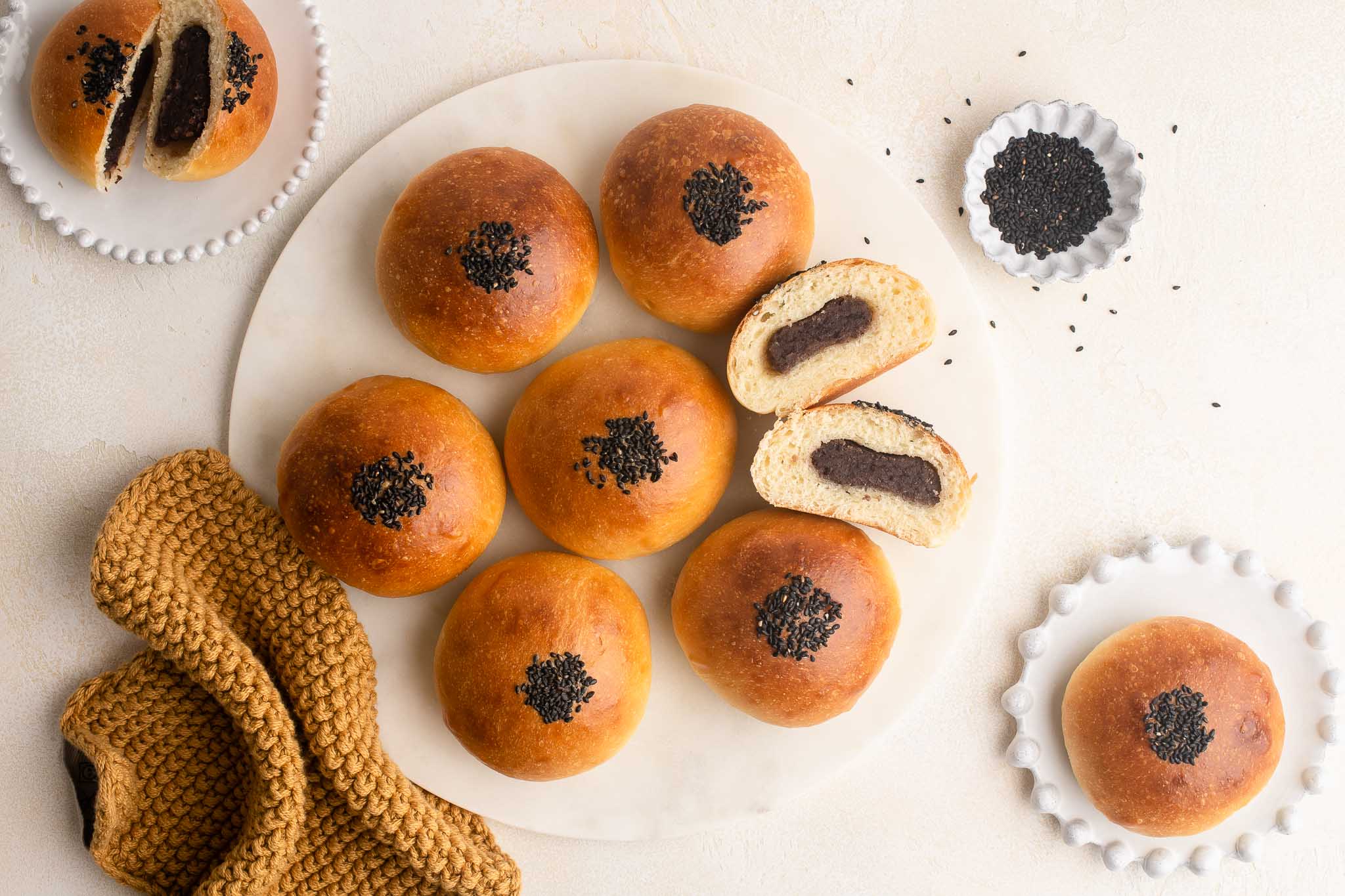
Japanese Red Bean Buns
My first encounter with Japanese baked goods was, surprisingly, here in Zurich. Having constant access to delicious cakes and pastries of Swiss, French, Italian and German origins is a luxury I never take for granted. But one day, I came across some baked pastries from a local Japanese baker, Hiro Takahashi, and I was intrigued because, although I had grown up eating Chinese cakes and pastries, I had never tried Japanese baked goods before.
The very first thing I tried was a Japanese Red Bean Bun, called Anpan in Japanese. The red bean filling was a familiar taste to me, and I loved the soft and squishy milk bread surrounding it. I was instantly hooked, and so were my kids.
What are Anpan?
Anpan are soft Japanese milk buns with a red bean filling. They are traditionally decorated with black sesame seeds on top of the buns.
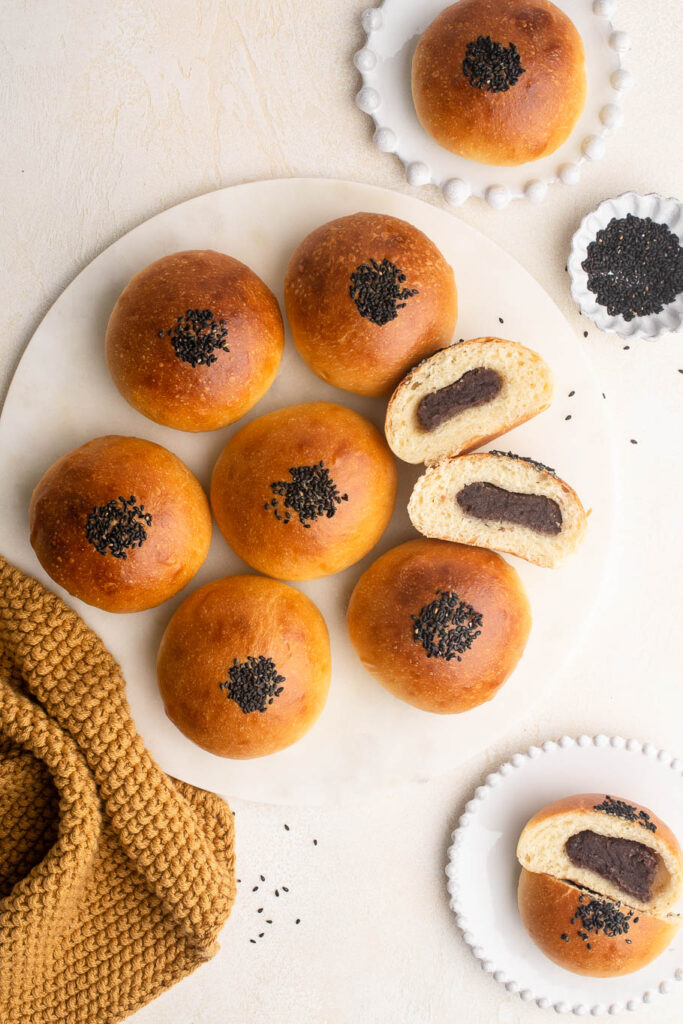
Japanese Bakery
Thanks to Hiro Takahashi, I discovered the wonderful world of Japanese Milk Bread and the countless ways you can transform the dough to create different types of filled buns.
My children particularly love the buns with chestnut filling, and I am rather impartial to the buns with green tea filling. There is also a kabocha pumpkin version in autumn which I always look forward to.
At home, I sometimes go through phases of baking with red bean paste, so if I have a batch of Homemade Red Bean Paste to hand, I love making these Japanese Red Bean Buns for my kids to eat at afternoon tea.
Homemade Red Bean Paste
As Red Bean Paste is not readily available where I live in Zurich, I make it at home from scratch. The process can seem long and fiddly, but it is a fairly easy recipe to make. It can even be worth making a large batch of Red Bean Paste to freeze in portions for use at a later time in other recipes, such as Mooncakes or Steamed Bao Buns.
How to Make Anpan
Making Anpan requires the following steps:
- Make the Red Bean Paste (or use store-bought)
- Make the Japanese Milk Buns
Making Japanese Milk Buns is very similar to making any other loaf of bread, except that you also add a floury paste to the dough. This paste, called a Yudane or Tangzhong, takes only a few minutes to make, but it makes all the difference to the finished loaf of bread.
Once you get started, you will quickly see that this milk bread recipe is quite similar to a brioche recipe, both in terms of ingredients, as well as texture of the dough.
Step 1
Make the Tangzhong by whisking together the ingredients in a small saucepan. Place the saucepan over low heat, and continue whisking until the mixture forms a thick paste. You want a thick enough consistency so that, as you whisk the mixture, the whisk leaves lines which do not move.
Scrape the Tangzhong into a small bowl and set it aside to cool. Once cooled, cover the bowl with clingfilm and place it in the fridge overnight.
If you are in a hurry, you can use the Tangzhong as soon as it has cooled to room temperature. But leaving the Tangzhong overnight allows it to develop more flavour.
Step 2
Measure the flour, yeast, salt and sugar into the bowl of an electric stand mixer. Lightly mix the ingredients together.
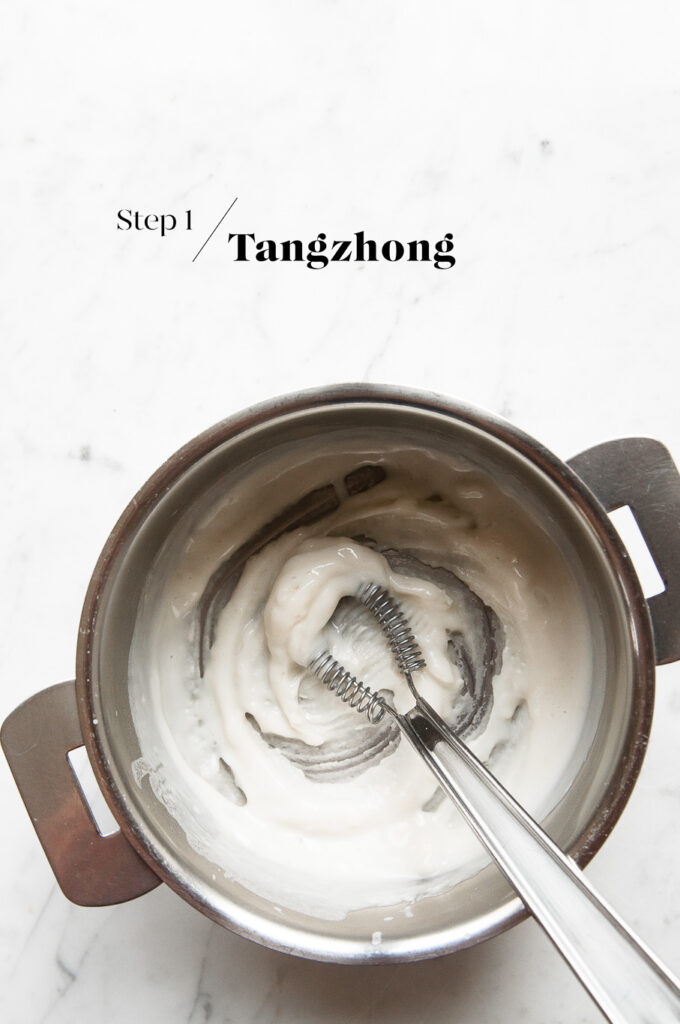
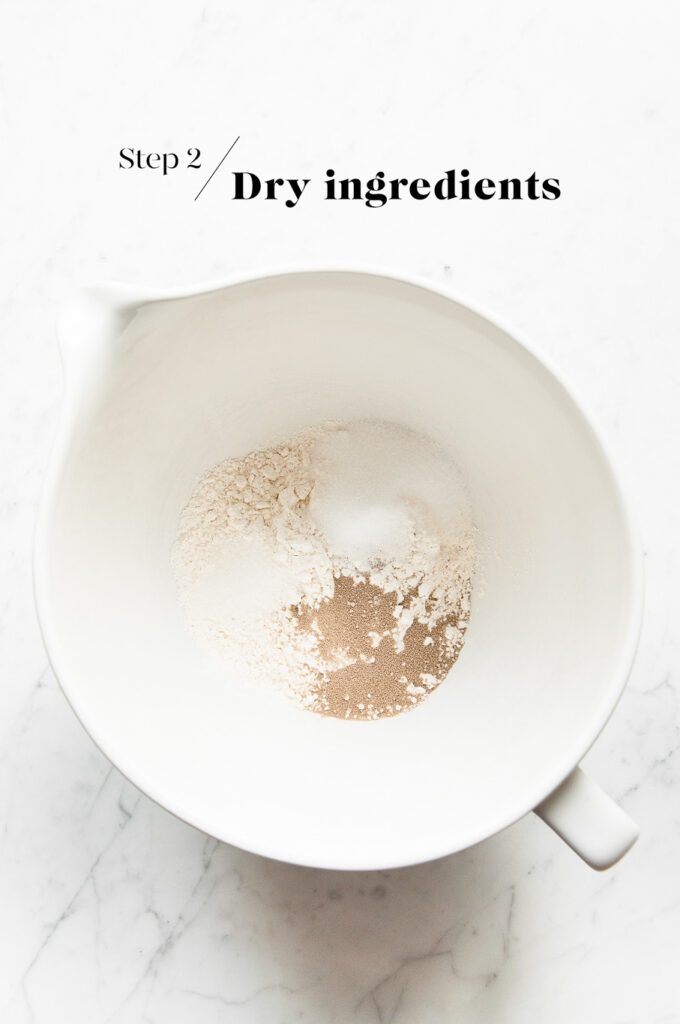
Step 3
Add the egg and Tangzhong. Use the dough hook to start to incorporate everything together. Slowly add the milk until a sticky dough starts to form. Then add the butter, one tablespoon at a time.
Step 4
Knead the dough on medium speed for 10-15 minutes until you have a dough which passes the windowpane test.
To perform the “windowpane test”, pinch off a small piece of dough, roll it into a ball and use your hands to gently stretch the dough. If the dough can stretch to form a thin sheet and be almost translucent so that you can see the light through it, your dough has passed the “windowpane test”. This means that you have kneaded the dough sufficiently and that the dough is ready to be proofed.
At this stage, the dough will be somewhat sticky and tacky, mostly because of the butter and high liquid content. But the dough should be coming away from the sides of the bowl during the mixing. Once the dough has had its first proofing, it will be less sticky to the touch and easier to handle.

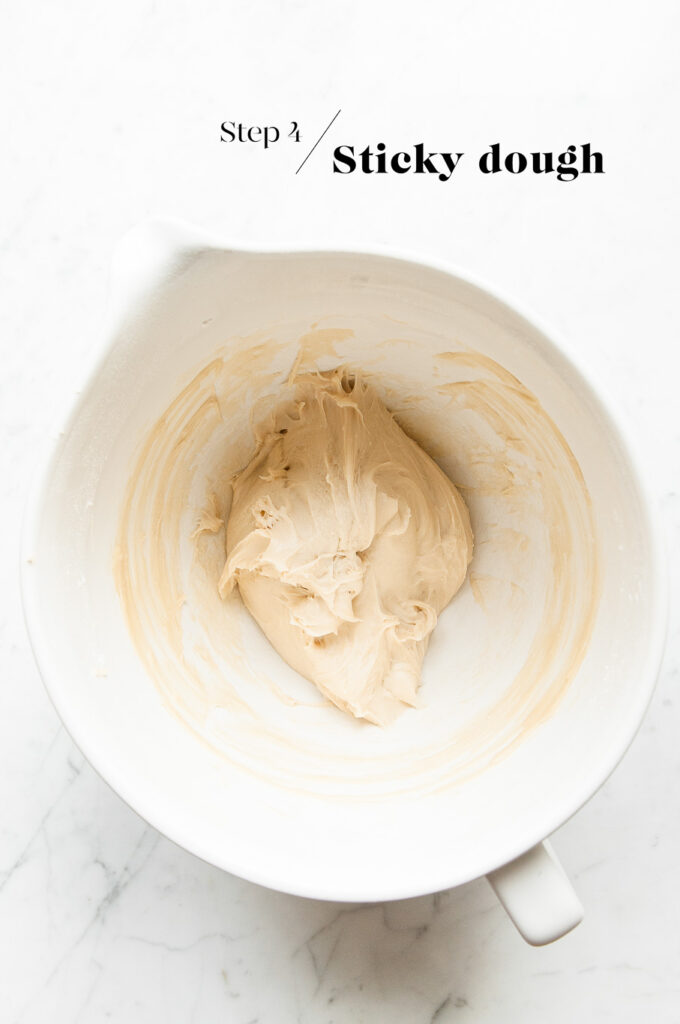
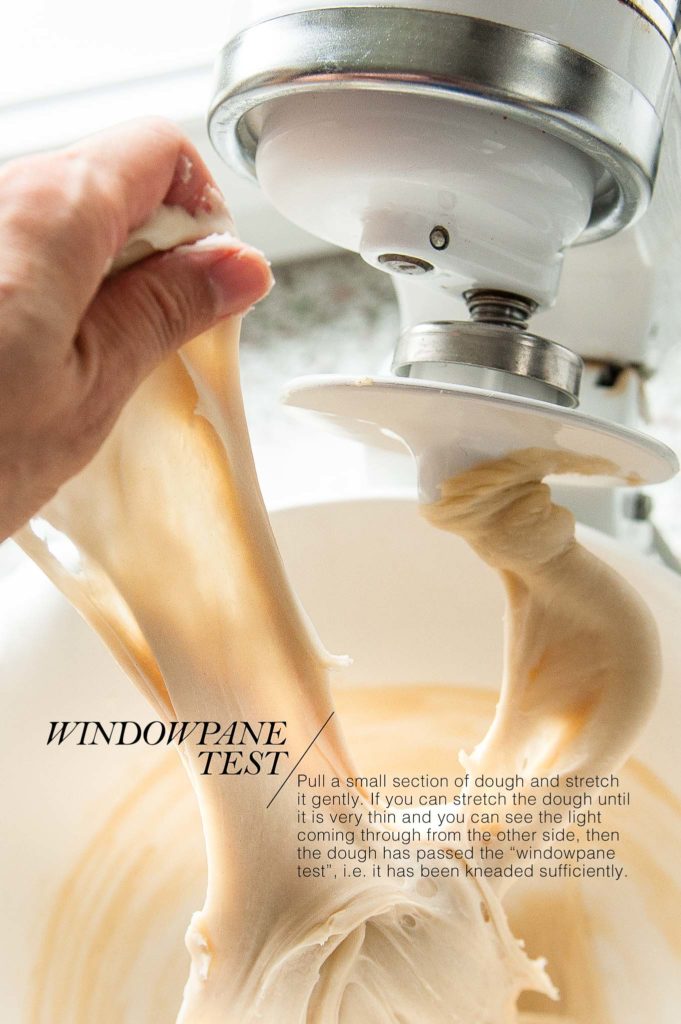
Step 5
Lightly oil a large mixing bowl. Roll the dough into a smooth-ish ball and place it inside the bowl.
Cover with a clean tea towel, and set it aside somewhere warm for about 1 hour, or until it has doubled in size.
Step 6
Once the dough has doubled in size, gently remove the dough from the bowl. The dough will deflate as you handle it.
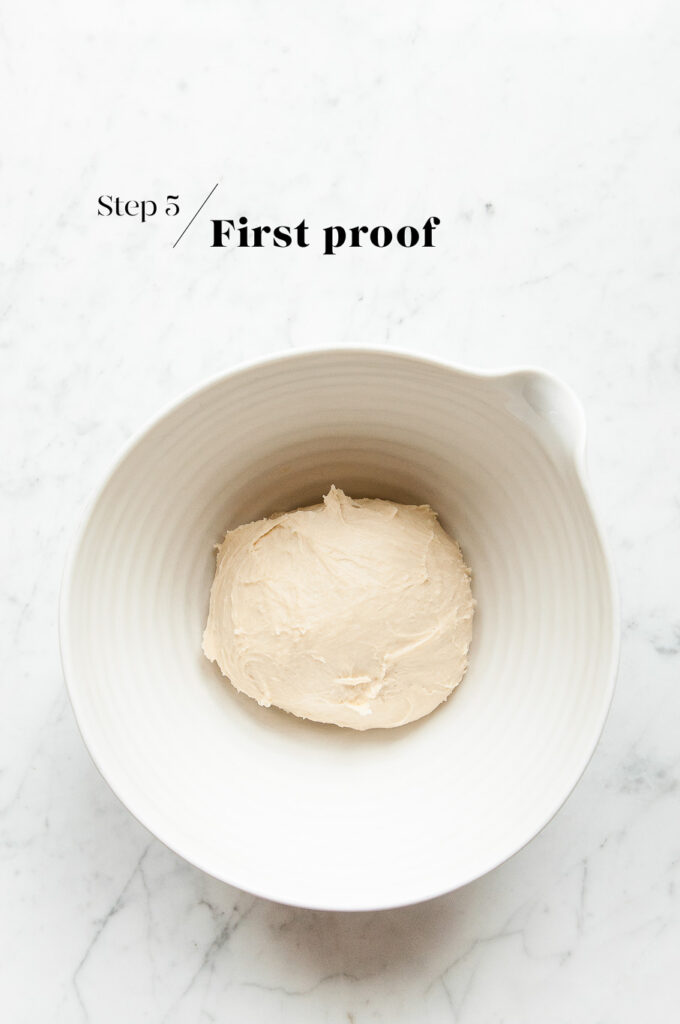
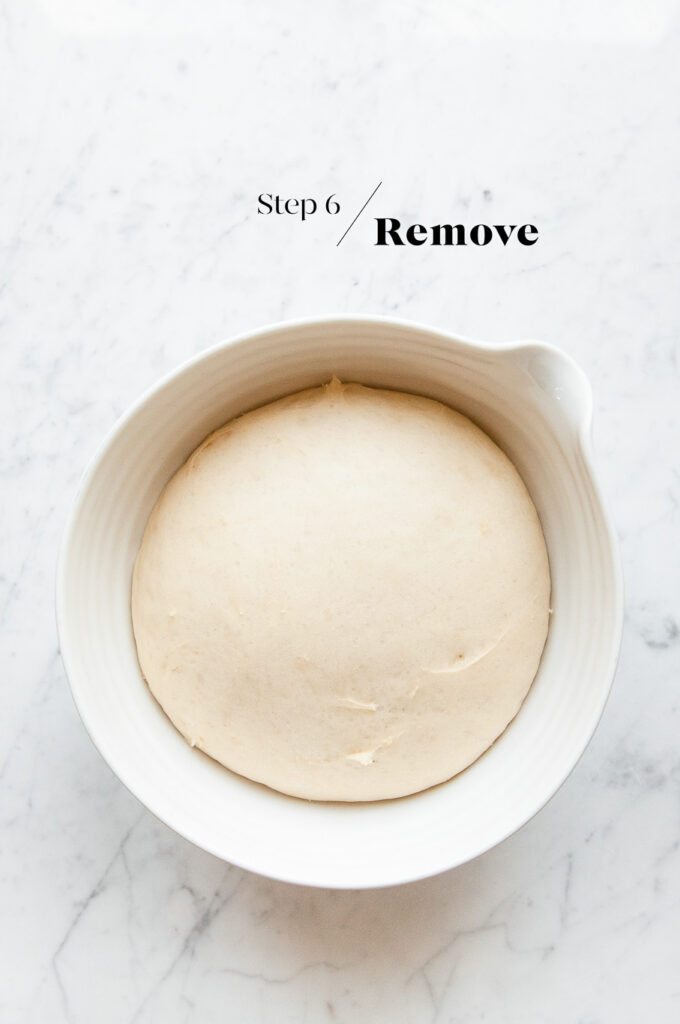
Step 7
Divide the dough into 9 equal portions (I recommend using a digital kitchen scale).
Step 8
If you are using Homemade Red Bean Paste, it should be cold from being stored in the fridge. Otherwise, if you are using store-bought red bean paste, place it in the fridge for easier handling later.
Portion the red bean paste into 9 equal portions, weighing 30 g each. Roll each portion of red bean paste into a smooth ball.
If the red bean paste you are using is quite soft and wet, you might find it easier to portion the paste using a spoon or ice-cream scoop.


Step 9
Using a small rolling pin to flatten a piece of dough, about 8-10 cm/3-4 inches in diameter.
Place a ball of red bean paste in the middle of the dough.
Cover the filling with the dough by pulling the edges of the dough into the centre, and then pinching those edges together while shaping the dough into a smooth ball as you do so. The pinched edges form the bottom of the buns.
Repeat with the remaining pieces of dough and filling.
Step 10
Place the filled buns onto a large baking sheet lined with baking paper, leaving enough room between the buns so that they can puff up without touching each other.
Red Bean Buns are traditionally baked as separate buns so that the whole bun can become nice and golden. However, for even softer and fluffier buns, I suggest making the Red Bean Buns like my recipe for Japanese Milk Buns, i.e. in a square baking pan so that the buns rise together, creating taller and softer buns.
Cover the pan with plastic wrap and leave it somewhere warm for about 30 minutes, or until the buns have almost doubled in size.

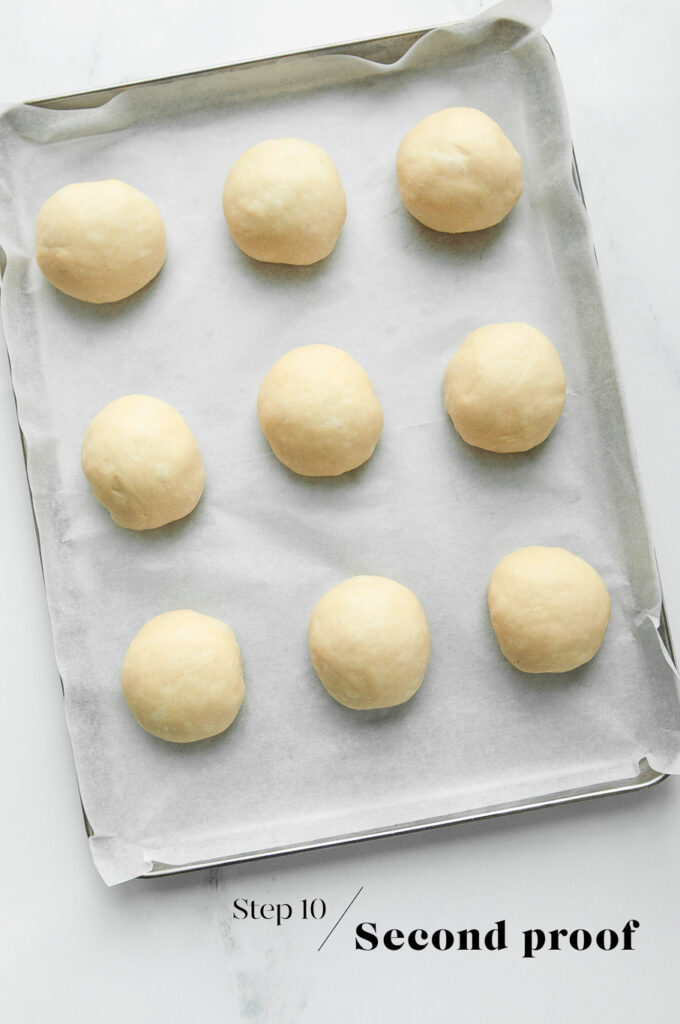
Step 11
Gently brush the buns with some egg wash.
Sprinkle the buns with some black sesame seeds. To do this the more traditional way, dip the end of a thick wooden spoon or similar (I use a wooden pestle) into the egg wash, and then dip the implement into a small bowl of black sesame seeds. Transfer the black sesame seeds to the bun by simply stamping the implement in the centre of the bun. Repeat this process for all buns.
Bake the buns for 20-25 minutes, or until the buns are lightly golden.
If the buns are browning too quickly (check at 10-15 minutes), loosely cover them with a sheet of foil for the rest of the baking time.

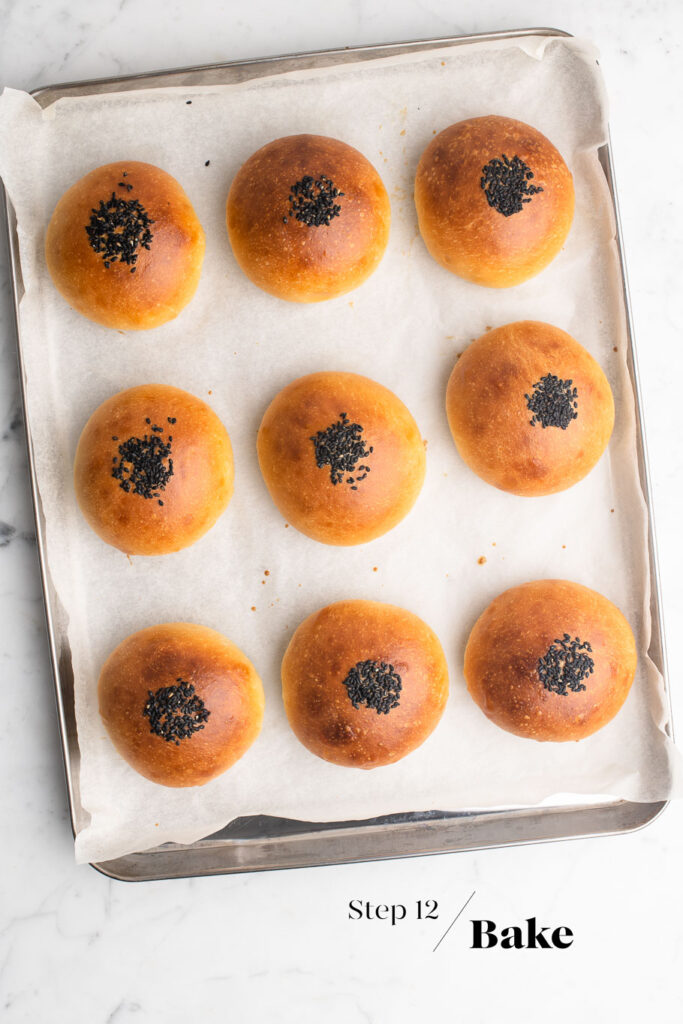
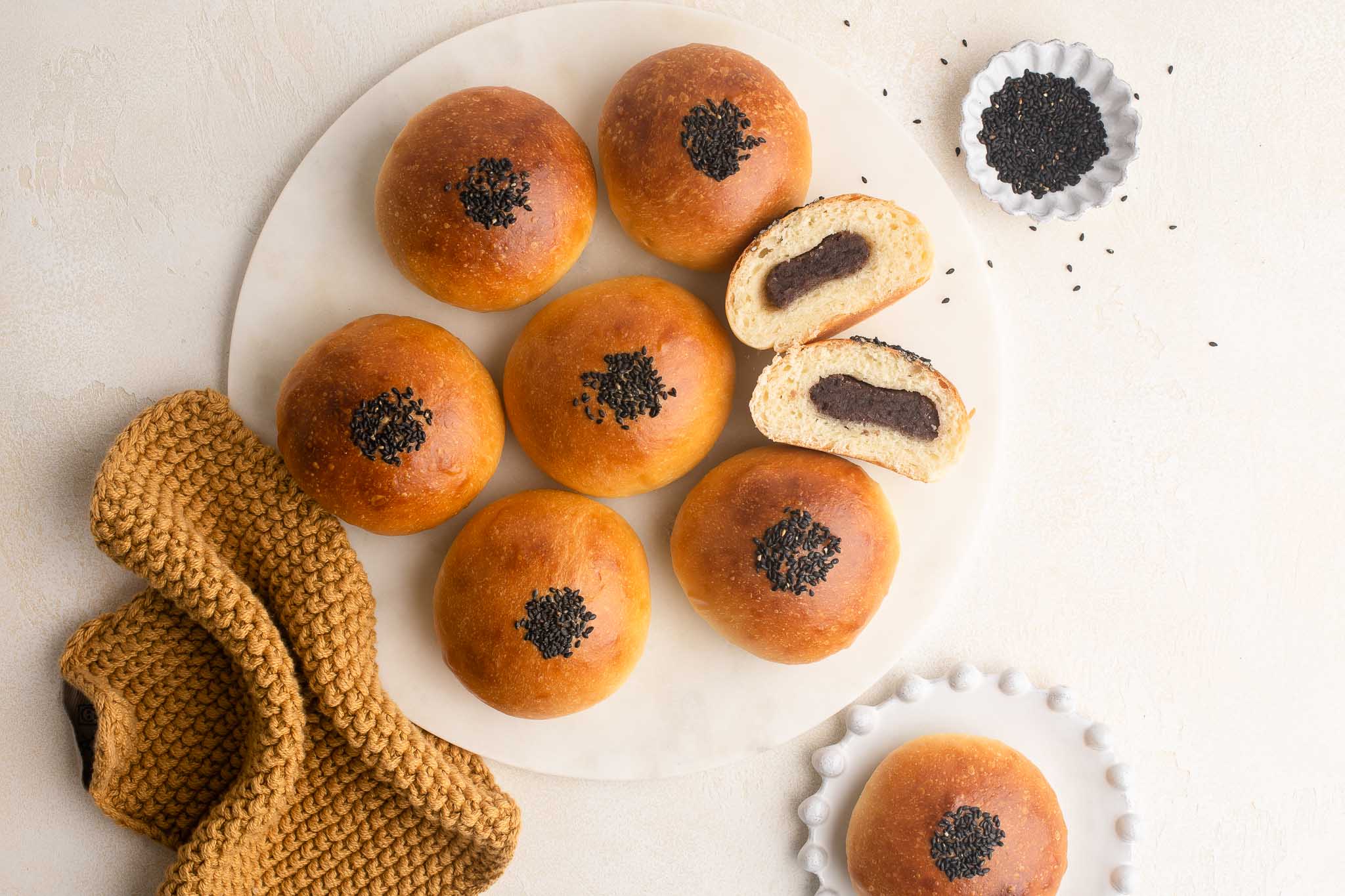
Japanese Red Bean Buns (Anpan)
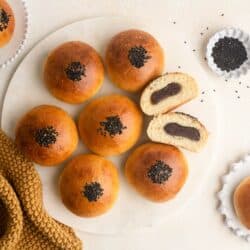
- Resting Time: 2 hours
- Prep Time: 45 mins
- Cook Time: 25 mins
- Total Time: 1 hour 10 minutes
- Yield: Makes 9 buns
- Category: Bread
- Method: Oven
- Cuisine: Japanese
Red Bean Buns made from soft and fluffy Japanese milk buns filled with red bean paste. These Red Bean Buns are a delicious snack for any time of the day! Recipe with step-by-step photos.
Ingredients
For the Tangzhong
- 2 tablespoons strong white bread flour
- 100 ml (1/3 cup plus 1 tablespoon) milk
For the Japanese Milk Bread Dough
- 350 g (2 1/3 cups) strong white bread flour
- 3 g (1 teaspoon) instant dried yeast
- 1 teaspoon fine salt
- 55 g (1/4 cup) caster sugar
- 1 egg
- 125 ml (1/2 cup) milk, warmed to 37°C/98°F
- 50 g (1/2 stick) unsalted butter, softened
For the Filling
- 270 g Red Bean Paste, fridge-cold
For the Eggwash
- 1 egg
- 1 tablespoon milk
To Decorate
- black sesame seeds
Instructions
For the Tangzhong
- Whisk the ingredients together in a small saucepan.
- Place the saucepan over low heat.
- Keep whisking until the ingredients form a thick paste. The consistency should be thick enough so that as you whisk the mixture, the whisk leaves lines in the mixture which remains.
- Remove the paste to a small bowl, and set it aside to cool down.
To Make the Dough
- Measure the flour, yeast, salt and sugar into the bowl of an electric stand mixer.
- Mix the dry ingredients together using a dough hook.
- Add the egg and the cooled Tangzhong.
- Slowly add the milk until the mixture comes together into a sticky dough.
- Add the butter, one tablespoon at a time. Wait for each tablespoon of butter to be fully incorporated into the dough before adding the next.
- Continue kneading the dough on medium speed for about 10-15 minutes, or until the dough passes the windowpane test. (See Kitchen Notes below). By this stage, the dough should also be coming away from the sides of the bowl.
- Lightly oil a large, clean mixing bowl.
- Roll the dough into a smooth ball and place it into the mixing bowl.
- Cover the dough with a clean tea towel or bowl cover, and place it somewhere warm for about 1.5 hours, or until it has doubled in size.
Portion the Filling
- While the dough is proofing, portion the red bean filling.
- Ideally, the red bean paste should be cold from the fridge for easier handling.
- Portion the red bean paste into 9 balls weighing 30 g each.
- Roll each portion into a small ball.
- Place the balls onto a large plate or tray, and place this in the fridge until ready to use.
- If the red bean paste you are using is quite soft and wet, you might find it easier to portion the paste using a spoon or ice-cream scoop.
Portion the Dough
- Gently remove the dough from the bowl. The dough will deflate as you handle it.
- Divide the dough into 9 equal portions. Use a digital scale for even-sized buns.
- Roll each piece of dough into a smooth ball.
Shaping the Dough
- Line a large sheet pan with baking paper.
- Use a small rolling pin to flatten a piece of dough, about 8-10 cm/3-4 inches in diameter.
- Place a piece of filling inside a piece of dough.
- Cover the filling with the dough by pulling the edges of the dough into the centre, and then pinching those edges together while shaping the dough into a smooth ball as you do so. The pinched edges form the bottom of the buns.
- Repeat the above steps with the remaining pieces of dough and filling.
- Place the shaped buns onto the lined sheet pan.
Proving the Shaped Dough
- Place the pan somewhere warm, covered with a clean tea towel, for about 30 minutes, or until the buns have almost doubled in size and are touching each other in the pan.
Baking the Red Bean Buns
- Preheat the oven to 180°C/356°F.
- Place a metal baking tray on the middle shelf.
- Lightly brush the buns with some egg wash.
- Sprinkle the buns with black sesame seeds. To do this the more traditional way, dip the end of a thick wooden spoon or similar (I use a wooden pestle) into the egg wash, and then dip the implement into a small bowl of black sesame seeds. Transfer the black sesame seeds to the bun by simply stamping the implement in the centre of the bun. Repeat this process for all buns.
- Bake the buns for about 20-25 minutes, or until they are lightly golden. Check the buns at about 10-15 minutes and, if they are browning too quickly, cover the buns with a loose sheet of foil for the remaining baking time.
- The buns are cooked if an internal thermometer reads 85°C/185°F.
- Leave the buns on the pan for about 5 minutes to firm up, before carefully removing the buns to a wire rack to cool completely.
- Serve warm or at room temperature.
Kitchen Notes
 WINDOWPANE TEST
WINDOWPANE TEST
Pinch off a small piece of dough, roll it into a ball and use your hands to gently stretch the dough. If the dough can stretch to form a thin sheet and be almost translucent so that you can see the light through it, your dough has passed the “windowpane test”. This means that you have kneaded the dough sufficiently and that the dough is ready to be proofed.
 MAKE AHEAD TIPS
MAKE AHEAD TIPS
To start the Milk Bread the night before, make the dough as per the recipe, until the dough has finished the first proofing period. Without touching or deflating the dough, cover the bowl with a tea towel, plastic wrap or reusable bowl cover. Place the bowl in the fridge to continue proofing overnight. The dough will rise slightly more overnight in the fridge. The next day, proceed with the rest of the recipe. As the dough will be cold, it may require a bit more time for the second proofing period.
 DIFFERENT TYPES OF FLOUR
DIFFERENT TYPES OF FLOUR
* For Swiss readers: I use Zopfmehl (or farine pour tresse) when making bread and enriched dough.
 DIFFERENT TYPES OF YEAST
DIFFERENT TYPES OF YEAST
* Please note that there is a difference between instant yeast (also called instant dried yeast or fast-action dried yeast) and dried yeast (also called active dry yeast). If you are not sure what type of yeast you have, please check the packaging for instructions on how to use the yeast.
* With instant yeast, you can add it directly to the flour mixture without having to activate it first.
* With dried yeast, you will need to activate it first (usually in some warm liquid).
 PROOFING THE DOUGH
PROOFING THE DOUGH
Dough needs a warm environment for the yeast to activate and cause the dough to rise. If you don’t have a warm place in your home, try one of the following ideas:
* In the oven with the oven light switched on (works only for some ovens).
* In the oven with a tray of boiling water on the bottom shelf.
* In the oven at a low temperature of about 25-30°C (77-86°F).
 OVEN & STOVE TEMPERATURES
OVEN & STOVE TEMPERATURES
All recipes on this website have been tested on an induction stove and/or with a conventional oven (i.e. an oven without fan). All recipes on this website use temperatures for a conventional oven, unless otherwise mentioned. Convection ovens (i.e. fan-forced ovens) are typically 20°C/70°F hotter than conventional ovens, but please check your manufacturer’s handbook.
 CONVERSIONS
CONVERSIONS
To convert from cups to grams, and vice-versa, please see this handy Conversion Chart for Basic Ingredients.

 Print
Print Pin Recipe
Pin Recipe Rate
Rate
Oh these look so beautiful! I can’t wait to try this recipe. I’ve made your Japanese milk buns many times, so I already know that this recipe will taste great.
Great recipe! I had trouble with browning the first time but made a second batch using just egg yolk and the tbsp milk and they browned like a charm.